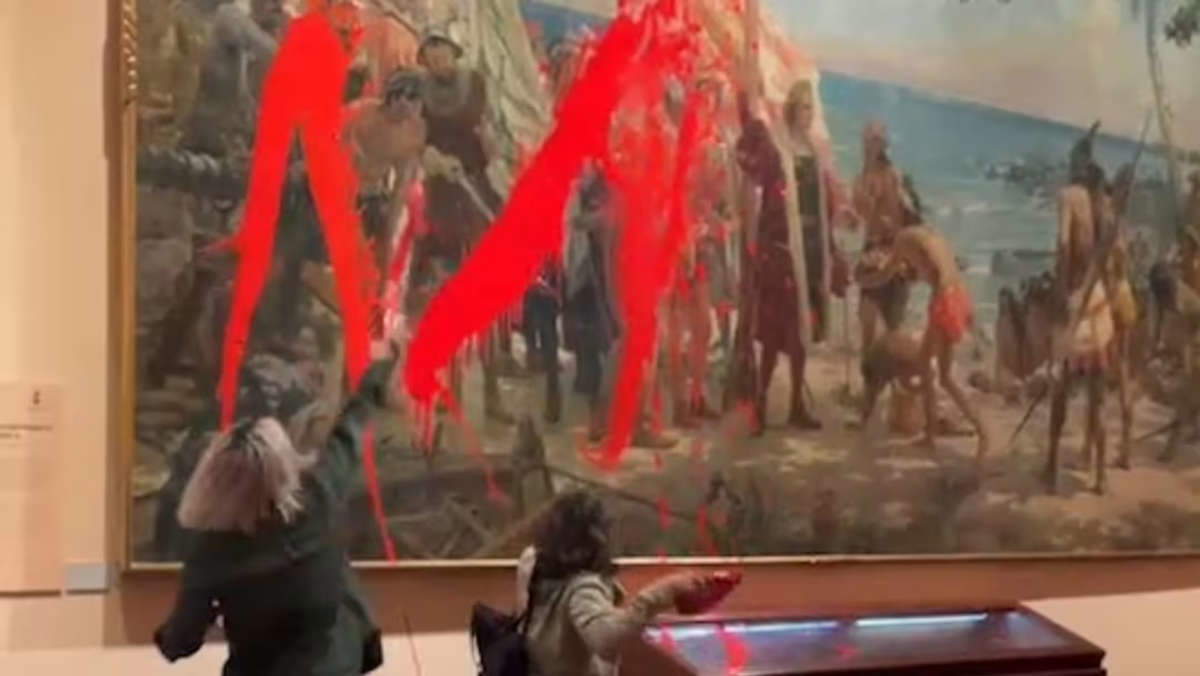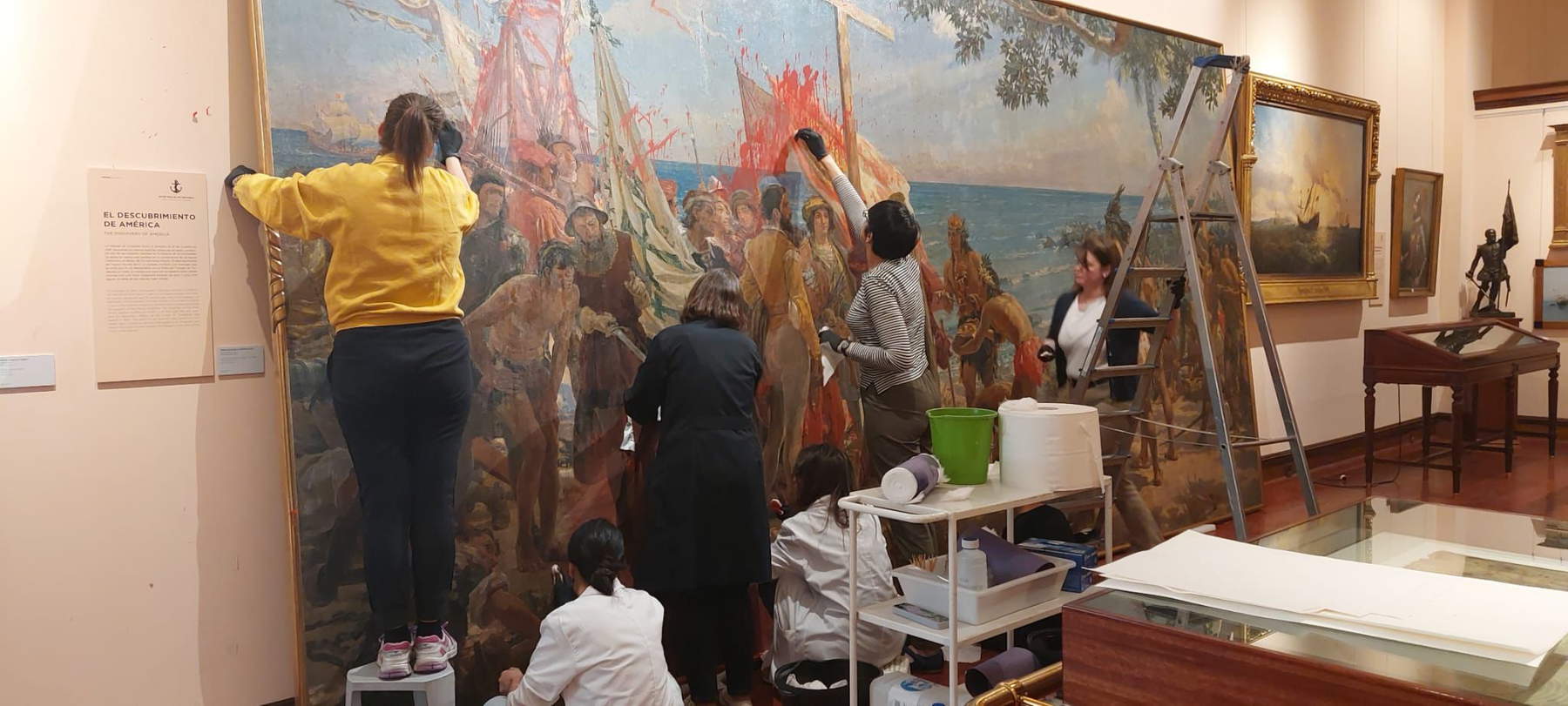Yesterday, Oct. 12, 2025, the anniversary of the discovery of America, at the Naval Museum in Madrid two activists, members of the collective called Futuro Vegetal, vandalized the painting titled Primer homenaje a Colón (12 de octubre de 1492), an 1892 work by Spanish artist José Garnelo y Alda (Enguera, 1866 - Montilla, 1944) depicting Christopher Columbus’ arrival on the new continent. The painting was not protected by any glass. The incident, immediately claimed by the group on social channels, happened around 2 p.m., when the two young protesters entered the museum facility and threw the red paint, declared “biodegradable,” on the left section of the large canvas. Interestingly, in the morning, a few hours before the incident, the museum had briefly illustrated the work on its social channels.
In a clip released on X, the Futuro Vegetal collective showed the protesters shouting slogans denouncing colonialism: in fact, the group made a direct connection between the commemoration of October 12, which is a national holiday in Spain, and what they have “the oppression that continues to this day” of indigenous peoples. The protesters explicitly stated that the historical legacy of Christopher Columbus symbolizes that same “dispossession and collective suffering” of which the October 12 date would be a symbol. Hence, therefore, the idea of striking a painting depicting Columbus.


Immediately after the attack, as seen in the video, Naval Museum staff promptly intervened and managed to stop the activists, who were later placed under arrest by the National Police. Unfortunately, however, the institute workers were unable to prevent the two women from throwing paint on the work. The damaged painting was covered and immediately removed from the exhibition hall to undergo initial evaluation by expert restorers and then paint removal operations.
The affected work, Primer homenaje a Colón (12 de octubre de 1492), constitutes an oil on canvas of considerable size, reaching three meters in height by six meters in width (300 x 600 cm). It was commissioned and made in 1892 specifically to celebrate the Fourth Centenary of the Discovery of the Americas. The subject depicted is a highly symbolic moment: the arrival of Christopher Columbus in 1492 and the tribute that the natives of the New World would pay to the navigator.
The painting’s historical importance is underscored by its history and success: it was exhibited at the International Exhibition of Fine Arts in Chicago also in 1892, where it also won a prize. The work is considered a landmark in the narrative of Spanish history. Currently, the painting is located at the entrance to the Naval Museum of Madrid (where it has been kept since 1981), a facility under the Armada Española that guards a valuable maritime and colonial heritage of the nation.


Although the Futuro Vegetal collective strenuously claimed that the varnish used was “organic and washable,” conservation and restoration specialists who took to social media raised serious and well-founded concerns, since even substances considered biodegradable or organic can inflict non-reversible damage on ancient works of art. Experts’ concerns relate in particular to the nature of the materials used: organic paint, which is typically formulated from vegetable oils or natural pigments, can in fact penetrate deeply into a canvas that, as in this case, is more than a hundred years old, and this can cause stains that become permanent, discoloration phenomena, or trigger chemical reactions that could alter the original colors.
In any case, a team of restorers, led by the museum’s technical director Berta Gasca, intervened immediately after the fact to remove the paint. It took six hours of work by the specialists, and now diagnostic investigations will be needed to assess any non-visible damage and to understand how the protective varnishes that the artist gave to the work to protect the oil painting may have reacted to the attack (the fear is that they may have deteriorated, so it will be necessary to see if more in-depth restoration will be needed after this initial intervention). To allow for all operations, the museum was closed after the vandalism incident.
Meanwhile, the two women, as mentioned above, were arrested. The act of vandalism against the work could constitute a criminal offense, under Article 323 of the Spanish Penal Code, damage inflicted on property of historical, artistic, scientific or monumental value: according to Article 323, anyone who causes damage to elements of protected cultural heritage is liable to imprisonment for six months to three years, or may be sentenced to pay a fine.
 |
| Madrid, activists throw paint at painting not protected by glass |
Warning: the translation into English of the original Italian article was created using automatic tools. We undertake to review all articles, but we do not guarantee the total absence of inaccuracies in the translation due to the program. You can find the original by clicking on the ITA button. If you find any mistake,please contact us.